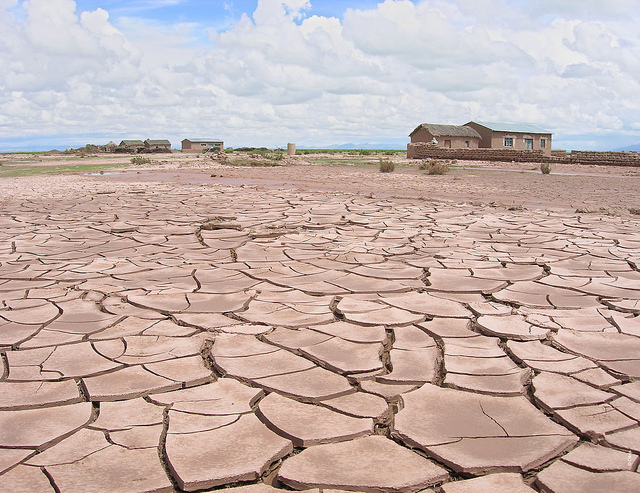 Drought in Bolivia. Photo credit: Flickr User European Commission DG ECHO
Drought in Bolivia. Photo credit: Flickr User European Commission DG ECHO
Water Wars in Bolivia, Again?
Bolivia recently declared a state of emergency due to the worst drought in 25 years. Almost every article on the subject notes in the last sentence that the crisis has triggered protests in major cities and “conflicts between miners and farmers over the use of aquifers.” One of the least developed countries in Latin America, the country experienced a “water war” 16 years ago when the city of Cochabamba privatized the city’s municipal water supply. Only resolved in 2006, these concluding sentences about the current emergency hint at the past. Will this new water crisis lead to another water war in Bolivia?
With a changing climate, water sources in Bolivia are not likely to improve. A recent study found that Bolivian glaciers shrunk by 43% since 1986. Throughout the year, 2.3 million people depend on the glaciers for 15% of their water (and that rises to 30% during the dry season). Currently in the rainy season, there are serious implications if in the next few months the anticipated rains are too weak or too extreme to recharge natural reservoirs. The drought has already affected 125,000 families and threatened 290,000 hectares of agricultural land and 360,000 heads of cattle.
The good news is that while the country remains one of the least developed countries, it also has one of the fastest growing economies in Latin America. This is due to currently high natural gas prices (the single most important export, making up ½ of the country’s 2015 budget) and president Evo Morales’ “prudent” macroeconomic policies. But, reliance on one commodity, natural gas, poses a serious long-term threat. Natural price fluctuation can be devastating if an economy is too dependent on one export for a substantial part of its income. In addition, some say that while President Morales policies have helped with inflation, it also has “exacerbated the unequal distribution of wealth.” This is a dangerous mix of variables; warming temperatures with decreasing rainwater, combined with a potential economic collapse and unequal wealth distribution could spell disaster.
The past offers a glimpse into the possible outcomes of renewed conflict. The previous conflict was sparked in late 1999 by a severe drought and subsequent privatization of the city of Cochabamba’s water source by a foreign consortium. This resulted in an increase in resident’s water bills by an average of 35%. Protests peaked with the death of a seventeen-year-old student, Victor Hugo Daza. The day after the student’s funeral, the consortium left and a new national water law was immediately passed. Unfortunately, Bolivian laws often take years to implement and after the protests, the management of the city’s water simply returned to the public utility.
While this crisis was resolved with relatively few deaths, the underlying issues still linger. Water distribution remains a challenge and poorer residents still pay considerably more than the wealthy. With water sources dwindling and rationing put in place, some have become desperate. In one city in particular, residents held authorities from a local water-distribution company hostage, demanding that the government explain its plans for dealing with the shortage. Will the next step be country-wide protests or conflict? The precedent exists, and with the growing wealth gap and a large percentage of the labor force dependent on agriculture, a lasting drought will have a significant impact on people’s livelihoods. In addition to all of this, over 50% of the population is under 24, the primary age group associated with the first set of protests.
Unfortunately, the situation in Bolivia is not unique. Growing climate change impacts have already begun to impact stability worldwide. We have seen this with the bread riots leading up to the Arab Uprising and the drying up of Lake Chad driving people to join Boko Haram in Nigeria. While all conflicts are complex and involve a multitude of variables, the impact of climate change as a threat multiplier cannot be understated. Bolivia is just another example of how climate change can undermine the stability of an already unstable state. Hopefully, by taking lessons from the past and analyzing the development of current crisis, future conflicts can be avoided, or at least mitigated.






